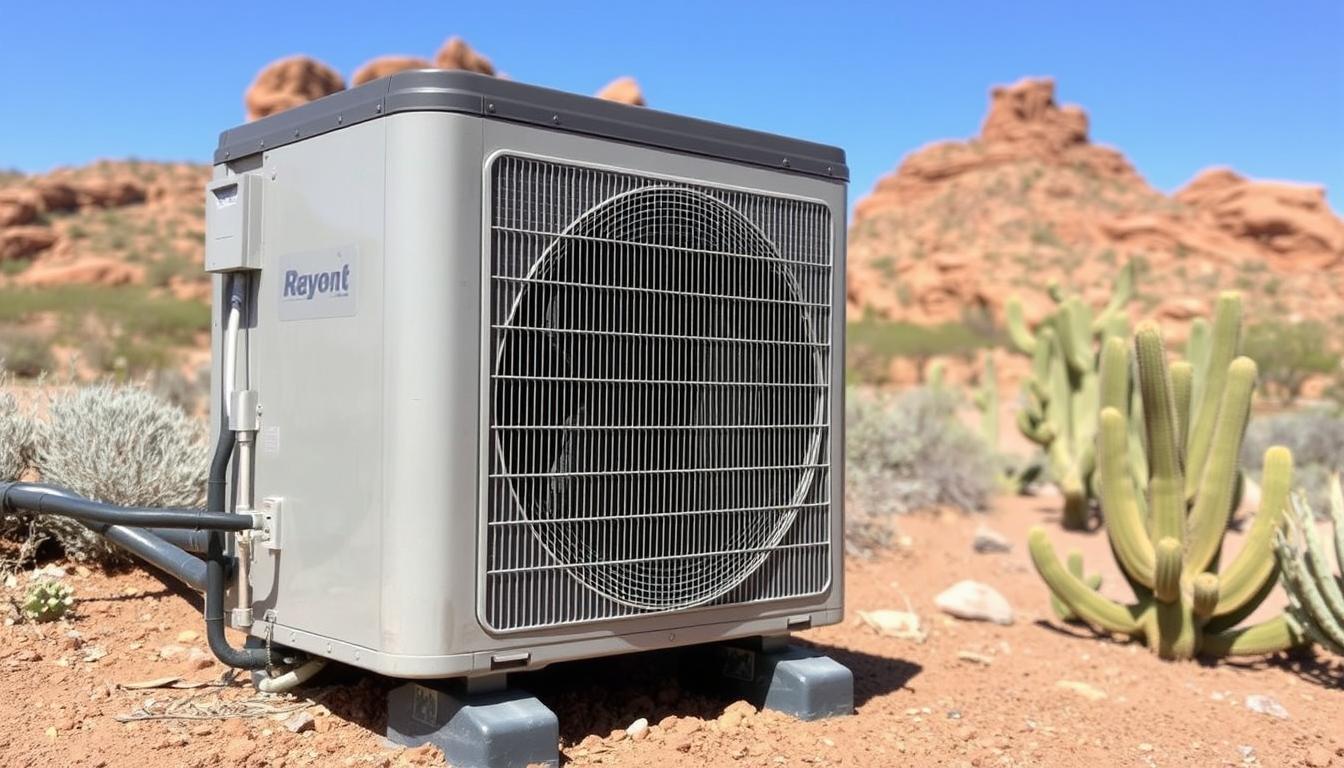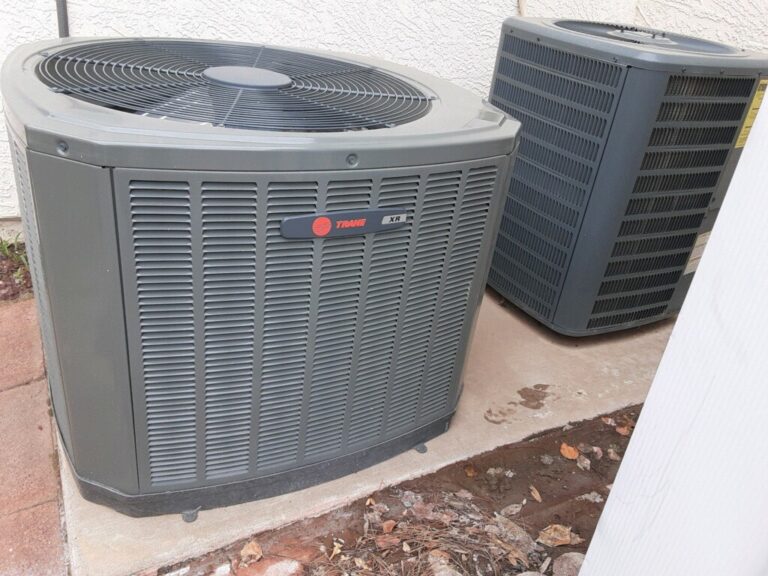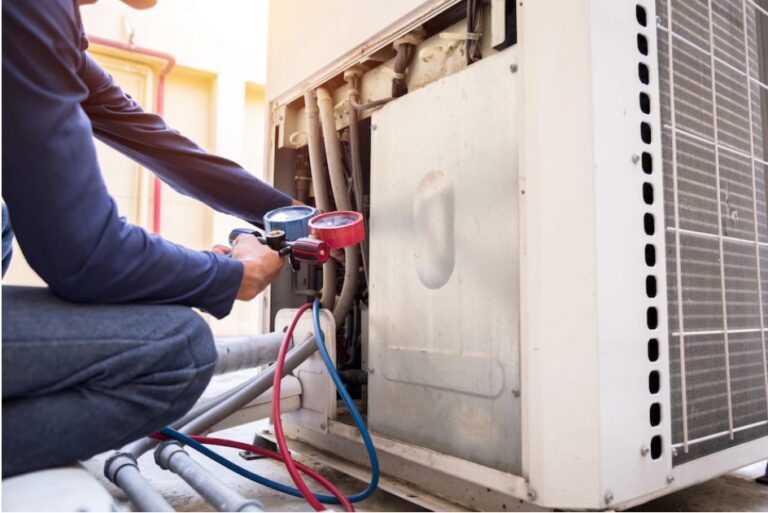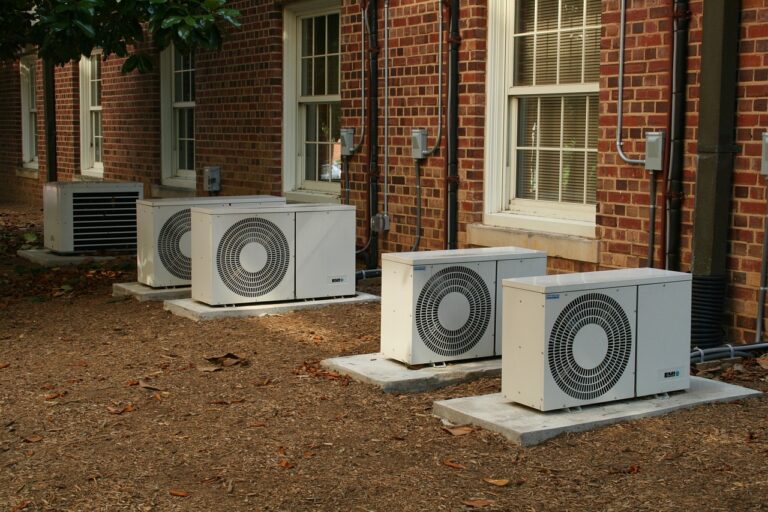How to Safely Reset Your AC Unit at Home
Resetting an air conditioning unit can be a straightforward process when broken down into manageable steps. For homeowners, understanding this process is crucial for maintaining a comfortable and efficient cooling system.
Our comprehensive guide will walk you through the steps to safely reset your AC unit. You’ll learn how to troubleshoot common issues and get maintenance tips. By following this guide, you’ll be able to diagnose minor problems and keep your AC unit running smoothly.
Resetting your AC unit can help resolve issues such as faulty thermostats or malfunctioning compressors. With this guide, you’ll gain the confidence to tackle these problems and ensure your cooling system operates efficiently.
Understanding Your AC Unit’s Reset Function
Knowing how to reset your AC unit can really help with common problems. Resetting your air conditioner is easy and can fix many issues. This includes small problems and errors in settings.
What Does Resetting Mean?
Resetting your AC unit means setting it back to its original settings. This is helpful after a power outage or if your AC isn’t working right. Resetting can fix problems from electrical surges or wrong thermostat settings, making your AC work better.
Common Reasons to Reset Your AC
There are many reasons to reset your AC. You might need to after a power outage, an electrical surge, or if it’s not cooling right. Also, if you’ve changed your thermostat and it’s not working, a reset could help.
Some specific situations that may require a reset include:
- Power interruptions
- Thermostat setting errors
- Minor malfunctions or glitches
As HVAC experts say, “Resetting the AC unit can often solve complex problems. It’s a simple fix for what seems like a big issue.”
Signs Your AC Needs a Reset
So, how do you know if your AC needs a reset? Look for signs like warm air when it should be cool, uneven temperatures, or if it won’t turn on. If you’ve checked the basics and still have problems, it’s time to reset your AC.
Other signs that a reset might be needed include:
- The AC unit is making strange noises
- The cooling is uneven or inconsistent
- The AC unit is not responding to thermostat changes
By knowing when and how to reset your AC, you can troubleshoot common issues effectively. This keeps your home comfortable. Resetting your AC can quickly fix problems from power outages or small glitches.
Safety First: Precautions Before Resetting
Before you reset your AC unit, it’s important to know the safety steps to take.
Turn Off the Power
First, turn off the AC unit’s power at the circuit breaker or fuse box. This is key to avoid electrical shock and keep you safe. Make sure the unit is fully powered down before you start.
Know Your AC Type
It’s crucial to know what kind of AC unit you have. Whether it’s central air, ductless mini-splits, or a window unit, each has its own reset steps. Check your unit’s manual or the manufacturer’s website for the right steps.
Keep Tools Handy
Having the right tools ready can make resetting easier. You’ll likely need a screwdriver, pliers, and maybe a multimeter for complex checks. Keep these tools close by before you begin.
Here’s a quick reference table for the safety precautions and tools needed:
| Safety Precaution | Importance Level | Tools Required |
|---|---|---|
| Turn off the power | High | Circuit breaker or fuse box |
| Know your AC type | Medium | AC unit manual or manufacturer’s website |
| Keep tools handy | Medium | Screwdriver, pliers, multimeter |
By taking these precautions, you can safely reset your AC unit. Always put safety first when working with electrical appliances.
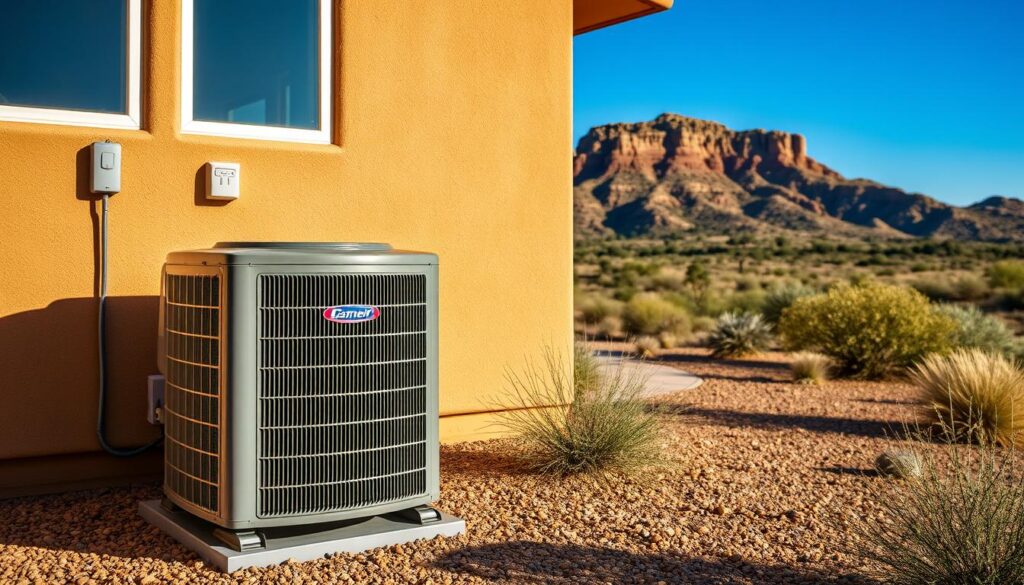
Step-by-Step Guide to Reset Your AC Unit
Resetting your AC unit is easy with the right steps. Even older models have a reset button or a simple process to follow.
Locate the Reset Button
The first step is to find the reset button. It’s often near the outdoor unit or on the control panel. If you can’t find it, check your owner’s manual.
Power Cycle Your Unit
If you can’t find a reset button, try power cycling. Turn off the AC at the circuit breaker or fuse box. Wait a few minutes, then turn it back on. This might fix the problem.
Use the Thermostat Reset Option
Some issues can be fixed by adjusting your thermostat. Look for a reset button or a restart option. This is key for temperature control problems.
By following these steps, you should reset your AC unit successfully. If you’re still unsure or the problem doesn’t go away, it’s time to call a professional.
Troubleshooting Common Issues After Resetting
Resetting your AC unit is just the first step. Troubleshooting common problems is crucial for optimal performance. After a reset, some issues might still persist, but there are several steps you can take to resolve them.
AC Won’t Turn On
If your AC unit fails to turn on after resetting, check the circuit breaker or fuse box. Ensure that the breaker hasn’t tripped or a fuse hasn’t blown. Sometimes, the issue might be as simple as a faulty thermostat setting or a dead battery in the thermostat.
- Check the power cord and plug for any damage.
- Ensure the thermostat is set to “cool” and the temperature is set low enough.
- If you’re using a smart thermostat, try restarting it.
Uneven Cooling
Uneven cooling can be frustrating. If some rooms are cooler than others, it might be due to blocked air vents, dirty filters, or issues with the ductwork. Regular maintenance can help mitigate these issues.
- Check and clean air filters regularly.
- Ensure all vents are open and unobstructed.
- Consider having your ductwork inspected for leaks or blockages.
Strange Noises
Strange noises coming from your AC unit can be alarming. Common causes include loose parts, debris in the fan, or issues with the compressor. If the reset button is not working, there may be underlying mechanical or electrical issues that require professional attention.
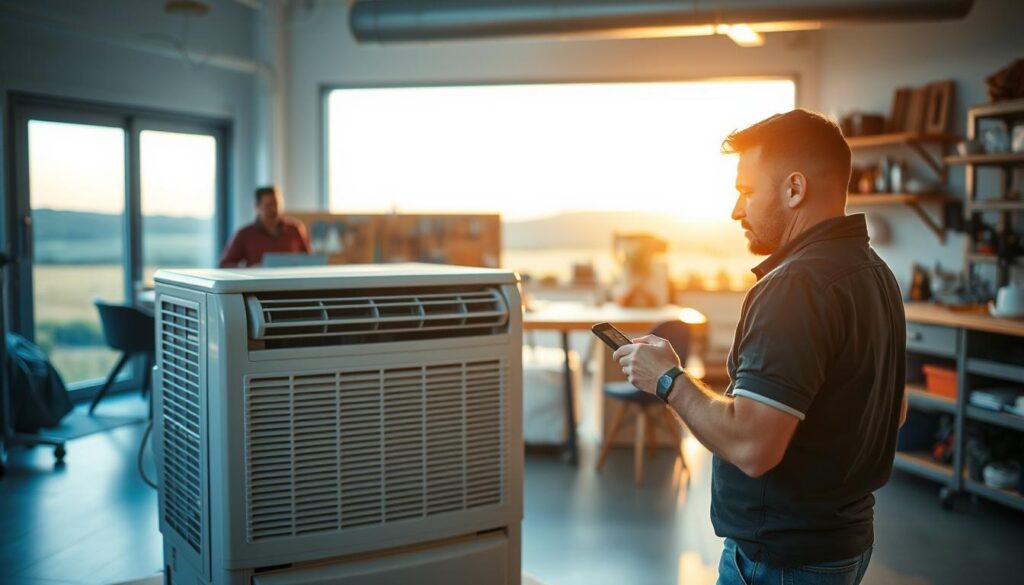
If you notice any unusual sounds, it’s a good idea to:
- Turn off the unit and inspect it for loose parts or debris.
- Check the fan blades for any obstructions.
- Contact a professional if the noise persists, as it could indicate a serious issue.
If you’re still experiencing issues after troubleshooting, it might be time to call in a professional. Your local One Hour Heating & Air Conditioning® can diagnose the root cause and recommend the necessary repairs to get your AC working efficiently again.
When to Call a Professional HVAC Technician
If resetting your AC doesn’t solve the problem, it’s time to call a pro. Some issues are too complex for a simple reset.
Signs of Major Problems
Some signs point to bigger AC problems. Frequent cycling and ice on coils are red flags. Unusual noises also hint at deeper issues.
If your AC won’t cool and you’ve checked filters and thermostats, it might have a refrigerant leak or a bad compressor.
Every One Hour® technicians are “licensed, experienced, and equipped to handle any air conditioning problems.” They’re the right people for complex AC issues.
Benefits of Professional Help
Getting a pro to fix your AC has many advantages. They can find and fix problems, ensuring your AC works well and safely. Every One Hour® technicians offer “prompt and professional cooling service and repairs to keep you and your family comfortable.”
“The best way to ensure your AC unit runs smoothly is by having it regularly maintained by a professional.”
Knowing when to call a pro helps avoid more damage to your AC. It also keeps it cooling efficiently.
Maintenance Tips to Prevent Issues
Keeping your AC unit in good shape is key for its long life and efficiency. A few simple steps can help avoid common problems. This way, your air conditioning system will work well for years.
Cleaning Filters Regularly
Cleaning or replacing air filters is a simple yet effective task. Dirty filters can cut down airflow, raise energy use, and harm your AC. It’s wise to clean or swap out filters every 1-2 months, based on how much you use it and the maker’s advice.
- Turn off the power to your AC unit before cleaning or replacing filters.
- Use a soft brush or vacuum to gently remove dust and debris from filters.
- If filters are too dirty or damaged, replace them with new ones that fit right.
Scheduling Annual Inspections
While you can clean filters yourself, getting a pro to check your AC yearly is also crucial. They’ll look at the condenser coils, check for leaks, and make sure everything’s working right.
Benefits of Annual Inspections:
- They catch problems early, before they get big.
- They make your AC more efficient and lower your energy bills.
- They help your AC last longer.
Monitoring Thermostat Settings
Your thermostat is key to your AC’s performance. Watching and tweaking the thermostat settings helps keep your home comfy while saving energy.
Tips for Thermostat Settings:
- Set the temperature to a reasonable level; extreme settings can stress your AC.
- Think about getting a smart thermostat for better control and energy savings.
- Use the “auto” mode instead of “on” to save energy and reduce wear on the unit.
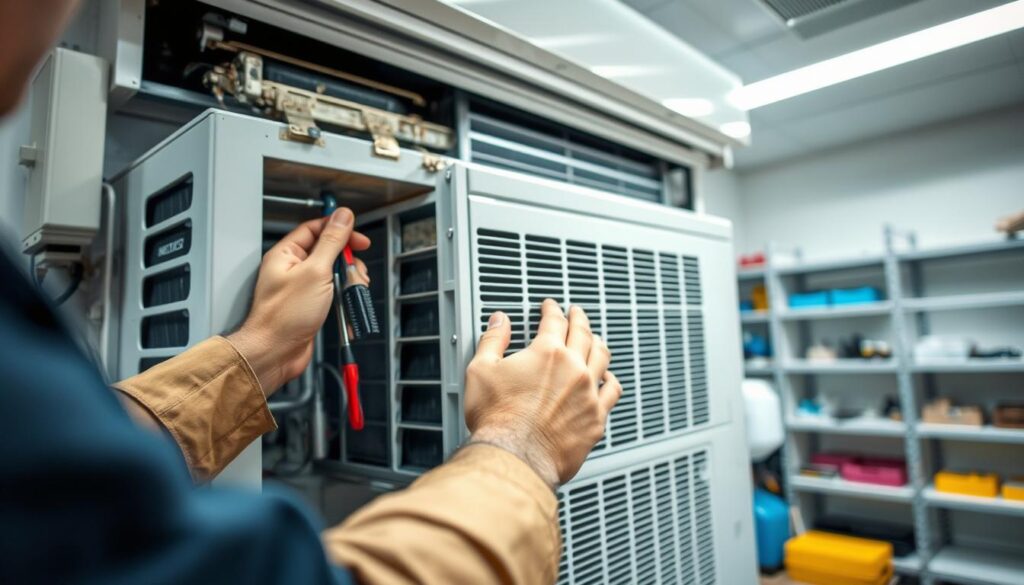
By following these maintenance tips, you can enjoy a cooler, more comfy home. Regular care not only prevents problems but also keeps your system running smoothly. This saves you money on your energy bills.
Energy Efficiency and Your AC Unit
Keeping your AC unit efficient is key to saving money and helping the environment. A better AC unit means lower bills and less harm to our planet.
Importance of Efficient Settings
Setting your AC unit right can cut down on energy use. Try setting the thermostat a bit higher. For example, a one-degree increase can save a lot of energy.
Programmable thermostats or smart AC controls can also help. They let you set temperatures for when you’re away or sleeping. This way, your AC unit doesn’t waste energy when you’re not using it.
Upgrading to Smart Thermostats
Getting a smart thermostat is a smart move for better energy use. Smart thermostats learn your habits and adjust the temperature for you. They also show you how much energy you use, helping you save more.
Plus, many smart thermostats work with smart home systems. This makes controlling your home easier and more efficient.
How Maintenance Affects Efficiency
Regular care is vital for your AC unit’s efficiency. Dirty filters and clogged coils make it work harder, using more energy. Clean or replace filters often and get annual checks to keep your AC running smoothly.
A well-kept AC unit uses less energy and lasts longer. It’s a smart investment. Upgrades like a new compressor can also save you money in the long run.
Conclusion and Final Thoughts
Resetting your AC unit is easy if you know the steps. By understanding how to reset your ac unit, you can keep it running well. This ensures your system works efficiently and effectively.
Key Takeaways
You now know how to reset your AC unit. This includes turning off the power, finding the reset button, and power cycling. Regular maintenance is also key. This includes cleaning coils and filters, checking refrigerant levels, and getting annual inspections.
Proper Maintenance Matters
Keeping your AC unit in good shape is important. By following the tips in this article, your system will cool your home better. And it will be less likely to break down. If your ac unit needs a reset, you know what to do now.
Final Tips for Homeowners
To keep your AC unit working well, watch your thermostat settings and clean filters often. Also, don’t forget to schedule annual inspections. These simple steps will make your home cooler and more comfortable. They’ll also help save on energy costs. Knowing how to reset your ac unit is just the start to a reliable cooling system.

